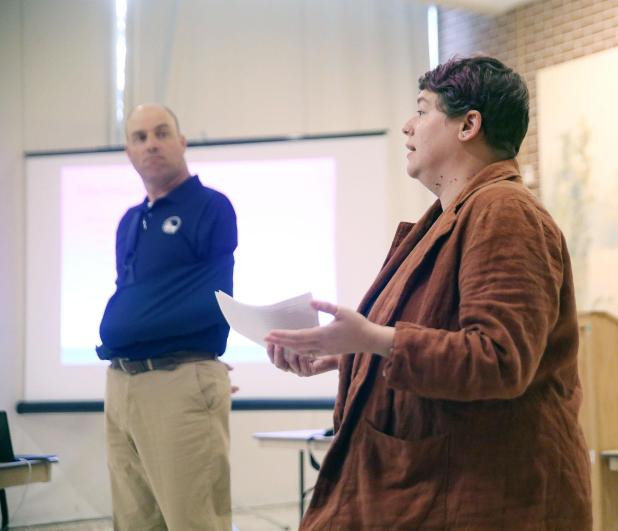
Brian Lezina of the Coastal Protection and Restoration Authority and Kristin Ransom of the National Oceanic and Atmospheric Administration lead Wednesday's meeting on the site selection for a Louisiana National Estuarine Research Reserve site.
The Review/Bill Decker
Research reserve site selection expected by early 2024
St. Mary Parish supporters of an Atchafalaya Basin site for a National Estuarine Research Reserve won their battle. But more work remains.
The reserve, which promises scientific, educational and economic benefits for the region, will be in the Basin, and likely as not in or close to St. Mary Parish, according to information at a Wednesday public meeting at Morgan City Municipal Auditorium.
Environmental impact statements and management plans must be complete before the community celebrates the site designation, expected in early 2024.
Then comes more time needed to put together a headquarters and an interpretive center.
“NOAA is ready to run,” said Kristin Ransom of the National Oceanic and Atmospheric Administration’s Office of Coastal Management. Ransom and Brian Lezina of the state Coastal Protection and Restoration Authority ran Wednesday’s meeting.
Authorities are taking public comments on possible sites at costal@la.gov through Nov. 10.
NOAA coordinates 30 National Estuarine Research Reserves in every marine coastal state except, but not for much longer, Louisiana. New reserves result from agreements between NOAA and the states where they’re located.
The states put up 30% of the operational funding, employ the reserve’s staff, implement programs and handle land ownership and management.
Federal authorities offer policy and program guidance, technical assistance, program coordination and 70% of funding.
The reserves monitor the coast; research the ecology of the areas where saltwater meets freshwater; and offer education opportunities for K-12 students.
Ransom said the latter may change to “K to gray” as the reserves reach out to larger segments of the community.
The Basin extends from Simmesport to the Morgan City area. But Lezina said the St. Mary Parish area has two features that make it unique on Louisiana’s coast.
“We have two active deltas,” he said.
The Wax Lake and Atchafalaya deltas are actually adding land to a Louisiana coast that has been losing marshland everywhere else.
Catherine Holcomb of St. Mary Excel, the citizens group that gathered public and private support for a St. Mary NERR site, made a pitch for locating facilities in Morgan City, where existing infrastructure such as bike trails could be incorporated.
State Sen. Bret Allain, R-Franklin, said the NERR can work hand in hand with the $25 million coastal research center at Nicholls State.
And Allain said he’s heard that NERRs can bring an economic impact totaling tens of millions.
“It’s a huge impact,” Ransom said.
Tyler McCollough, a Morgan City High student, likes the educational angle.
“I think this gives us an opportunity to go out and learn about the environment,” he said.
Progress toward creating the NERR now turns to the development of draft and final environmental impact statements and management plans. When those documents are hammered out, NOAA and the state government will enter a memorandum of understanding.
